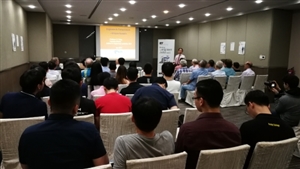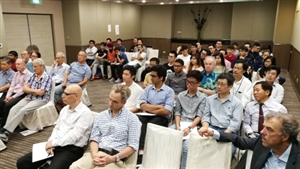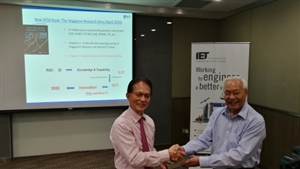
Introduced by our very own Mike Henry was Prof CC Hang the executive Director of the Institute for Engineering Leadership at the National University of Singapore and co-writer of the new book “The Singapore Research Story” [http://www.eng.nus.edu.sg/IEL/book-singapore-research-story/index.html] who was here to share with us his thoughts and expertise on ‘Engineers as Entrepreneurs.
His great passion, he quickly shared, was to spend tax payers money... on building research and innovation within Singapore and to help develop engineering start-ups.

He started by explaining to us examples of Singaporean entrepreneurship which included start-ups created by fresh graduates which with some of the world’s fastest 3-D printers using mesh stereolithography techniques to produce clear aligners for dentists, start-ups created by experienced precision engineers who produce quality custom made parts for other start-ups as well as an example of a company started by a senior level manager. To round off he also told the story of how the Keppel group of shipbuilders in Singapore was considered a sunset industry seemingly doomed to slowly decline was turned around by its leaders who took the decision to start designing oil rig jacks . Up until then, the company only built ships and had never ventured into the design aspect of marine engineering and today, thanks to this risk having been taken, Keppel is now the world’s largest offshore rig manufacturer.
This shows not only that entrepreneur can come from all levels of experience but also that it can be done from within an existing organisation.
That being said, Singapore does not rate very highly in the Global Innovation Index [https://www.globalinnovationindex.org/]. In terms of investment or ‘input’ in Research and Development per capita, Singapore it seems is first in the world! In terms of actual ‘output’ however, Singapore is but seventeenth... in terms of efficiency, Singapore was ranked sixty-third... Let that sink in for a second.
Input into R&D : #1
Output from R&D: #17
R&D efficiency: #63
So while Singapore invests a great amount of resources into research, it is not resulting in much overall gain for the country or for companies based here. The biggest reason is a lack of entrepreneurship needed to bridge the gap between research and business. To take the new technologies and apply them into real world applications.
So, we need more entrepreneurs, great, how does one without a doctorate or national lottery winnings even begin? The audience quietly demanded... Essentially, it’s all in the mind-set.
Based on the Toronto model, an engineer can have three ways of leading:
1 – Lead by passing technical expertise to others. This is basically what engineers do. Get knowledge and pass it on to others in the team.
2 – Lead by collaboration. So, teamwork; have a team of people with different areas of expertise and make them talk to each other to solve a problem.
3 – Lead by translating technical knowledge into innovation. Finding new ways to do things. This, especially is something which does not necessarily need an enormous amount of field expertise as it can be as simple as looking at a new technology and then thinking of new ways to apply it.

Once you have found your idea, the next step is to have a good business model. For this, the budding entrepreneur needs a profit formula and a customer value proposition. Basically, this means that you need to identify your customer base. Will it be sold to old or young people (or both), will you target companies or individuals, will you rent your equipment or sell it, will you be working within developed or developing markets, how much will you charge for your product, how much will it cost you to make. Will you sell the main unit for a low price but make the consumables expensive... the list goes on.
In the end, being an entrepreneur is not easy and it might be many years of effort, setbacks and sacrifice before your labour bears any fruit. Seeing this, most people in Singapore or indeed much of the rest of the world, would do the sums and come to the conclusion that they would rather stick to their steady jobs and spend their money on luxuries like expensive cars.

Fundamentally, entrepreneurs are optimists. If you want to achieve success the best advice provided by Prof. Hang is to not think too much about it and do not give up too early as it will take time for the business to start growing, sometimes after several setbacks. A good idea might be to treat it as a side-hustle while you go about your day job for the start then you can leave your job and start running your business full time once it has begun to take shape. Remember to build a good team around you to help the business grow and not to let what may at times seem like unsurmountable setbacks defeat you. This is not for everybody. Many people will rightly decide that working hard for uncertain rewards is not for them and there is no guarantee of success. That being said, as Jeff Bezos once said upon leaving his high paying job in Wall Street to start Amazon:
“I knew that if I failed I wouldn’t regret that, but I knew the one thing I might regret is not trying.”

Morgan Bonici
IET Young Professionals SG
